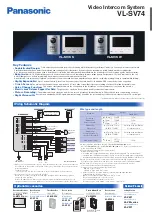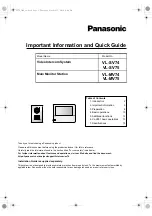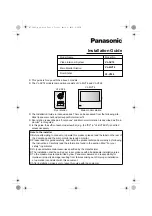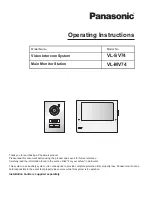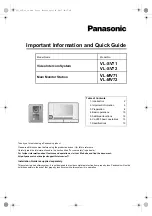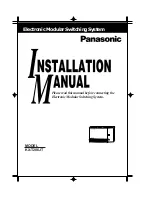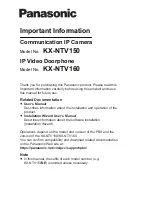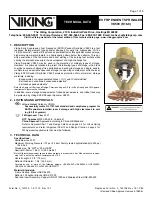
3
to the building structure. Otherwise,
reaction forces from system initiation
could alter the sprinkler alignment
and disrupt the distribution pattern.
Step 3. Use only a non-hardening
pipe joint compound or Teflon* tape.
Apply only to the male threads.
Step 4. Hand tighten the sprinkler
into the fitting. Use a Central
Sprinkler Omega Model R-1
Sprinkler Wrench to tighten the unit
into the fitting. The wrench attaches
easily to any 1/2" socket drive rachet.
A leak tight joint requires the
application of only 7-14 ft.-lbs. of
torque. A tangential force of 14-28
lbs. delivered through a 6" handle will
deliver adequate torque. Torque
levels over 21 ft.-lbs. may distort the
orifice seal, resulting in leakage.
*Teflon is a trademark of the DuPont Corp.
Maximum Spacing Maximum Distance
Minimum Design Flow (pressure)
Between
from Any
Two or
Sprinklers
Wall
One Sprinkler
More Sprinklers
Design
Data
12 feet (or less)
6 feet (or less)
10 GPM (6.6 psi)
9 GPM (5.3 psi)
14 feet
7 feet
10 GPM (6.6 psi)
9 GPM (5.3 psi)
16 feet
8 feet
14 GPM (12.9 psi) 11 GPM (8.0 psi)
18 feet
9 feet
14 GPM (12.9 psi) 12 GPM (9.5 psi)
20 feet
10 feet
16 GPM (16.8 psi) 16 GPM (16.8 psi)
Sprinklers must be handled
carefully. They must not be
transported or stored where ambient
temperatures may exceed 100
o
F/
38
o
C. For best results, store them in a
cool, dry location in the original
shipping package.
Do not install sprinklers that have
been dropped or visibly damaged.
Sprinklers must never be painted,
coated, plated, or altered in any other
way from manufactured condition or
they may not function properly. Any
sprinklers altered in such manner
must be replaced.
The owner is responsible for the
proper operating condition of all fire
protection devices and accessories.
The NFPA Standard 25 entitled,
"Inspection, Testing and Maintenance
of Water-Based Fire Protection
Systems", contains guidelines and
minimum maintenance requirements.
Furthermore, the local
Authority
Having Jurisdiction may have
additional regulations and
requirements for maintenance, testing
and inspection that must be obeyed.
It is recommended that sprinkler
systems be inspected regularly by a
Care &
Maintenance
qualified inspection service. Length
of time between such inspections can
vary due to accessibility, ambient
atmosphere, water supply and site
activity.
Do not attempt to re-assemble or
otherwise reuse a sprinkler that has
operated. Replace any sprinkler
exhibiting corrosion or damage;
always use new sprinklers of the
same type and temperature rating as
replacements.
Because the discharge pattern is
critical to protection of life and
property, nothing should be hung or
attached to the sprinkler unit that
would disrupt the pattern. Such
obstructions must be removed. In the
event that construction has altered
the original configuration, additional
sprinklers may need to be installed to
maintain the protection level.
Do not attempt to replace sprinklers
without first removing the fire
protection system from service.
Be certain to secure permission
from all Authorities Having
Jurisdiction, and notify all personnel
who may be affected during system
shutdown. A fire watch during
maintenance periods is a
recommended precaution.
To remove the system from service
mode, first refer to the system
operating guide and valve
Design Requirements — Residential Applications
Special care must be taken when installing with a copper system.
Sprinklers must be installed only after the inside of the sprinkler drop and
associated fittings have been wire brushed to remove any flux. Residual flux
can cause corrosion and in extreme cases can impair proper sprinkler
operation.
Omega Adjustable
(Part #15674100)
Step 5. To install the Model R-1A
Escutcheon Plate, align it with and
press it over the sprinkler body until the
outer edge of the escutcheon meets
the mounting surface.
Do not over or under tighten the
sprinkler to compensate for inaccurate
escutcheon plate adjustment.
Readjust the sprinkler fitting as
required.
Never add any leak stopping
additives to a sprinkler system. It
will impair the operation of the
sprinklers and is strictly prohibited.
Caution: Special care must be taken
when installing with a CPVC system.
Sprinklers must be installed after the
CPVC manufacturer's recommended
setting time for the primer and cement
to ensure that neither accumulate
within the sprinkler.
OBSOLETE





